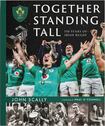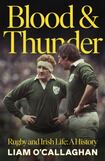

When the Irish Rugby Football Union celebrated its centenary 50 years ago, one of the few books about Irish rugby was the union’s history by Edmund Van Esbeck, then the Irish Times rugby correspondent.
Yet in the past 20 years, more than a dozen Irish players and coaches have written memoirs. Perhaps this is an inevitable consequence of the commercialisation which Van Esbeck so stoutly resisted. If the field is crowded, the Irish team’s recent successes will have whetted the appetite of fans, and these two books will give them something to cheer about.
For anyone commissioned to write the official story of a sports organisation, one of the challenges is to avoid simply providing an arid chronology.
In Together Standing Tall, John Scally wisely incorporates the appealing immediacy of the interview-based format used in Tom English’s No Borders and Alan English’s Grand Slam to help propel the union’s story forward from its quirky beginnings to its current status as a professional business.
READ MORE
Scally also dutifully records the triumphs and disasters, the Grand Slams as well as the most recent traumatic World Cup quarter-final exit.
Sumptuously produced, with many excellent photos from the Inpho agency, the book is also peppered with anecdotes. Celebrating in the Irish embassy after the famous 1948 Paris win, some of the team quaff champagne “like stout” while the Dolphin lads clamour for red lemonade.
The sometimes brutal nature of the club game is acknowledged by Con Houlihan, who says he was never capped for Ireland, but was kneecapped for Castleisland. Joe Schmidt reveals his pragmatism in the early advice he gives to Wilson’s Hospital school’s team: “Don’t smoke in the showers”.
There are chapters on the provinces, the clubs, and the schools as well as a chapter on women’s rugby. Remarkably, the first live televised Irish women’s international was in 2013, 20 years after they began playing the sport. Scally quotes tennis legend Billie Jean King: “You have to see it to be it”.
Rigorously researched and incisively written, Blood and Thunder, as its subtitle suggests, is an account of how rugby became part of Ireland’s social fabric. O’Callaghan opens with a breezy discussion on the search for an acceptable team anthem, moving from God Save The King to Amhrán na bhFiann (a rebel ditty, according to the Belfast News Letter) and even The Rose of Tralee before settling on the depressingly worthy Ireland’s Call.
O’Callaghan’s bracing style is refreshing. Dismissing the giddiness around Munster Rugby as “folksy, confected tribalism”, he argues that Ulster had a far greater sense of provincial identity (perhaps because of the various Home Rule crises it faced) while Limerick and Cork were constantly at each other’s throats.
He also slates the “brattish entitlement, the carnivalesque, ritualistic” nature of the Leinster Schools Senior Cup, as well as condemning the IRFU for at times treating Connacht like “the gormless young cousin”.
Criticicing the IRFU is often an easy three-pointer, and O’Callaghan converts every chance he gets.
There is an almost comic snobbery about the union’s early fretting over whether to permit junior working-class Limerick clubs to play on Sundays, lest the IRFU would look like the GAA. The “heroic pettifogging” over player payments (Garryowen were scolded for discharging an injured player’s medical expenses) seems even more ludicrous alongside one treasurer’s threat to increase Lansdowne Road ticket prices so as to “keep out the roughs”.
The beginning of the professional game in the 1990s may have coincided with the end of social and religious deference in Ireland, but the union has sometimes struggled to shake off its snooty reputation.
Their refusal to cancel the 1981 South African tour in the teeth of government opposition and public outrage was born out of stubborn loyalty to their “blazers-in-arms”, while the response to woman players’ pleas for practical structural support in 2021 is “tin-eared and defensive”.
A chilling chapter on injuries – and concussion in particular - opens with the sad fate of Ken Nuzum, a Lansdowne legend.
Nuzum’s death in 2013, aged 57, from Chronic Traumatic Encephalopathy (CTE) was a shock to Irish rugby. O’Callaghan wonders if the initial silence on concussion was due to “an elaborate conspiracy of concealment” among players, coaches, officials and sometimes medics.
The psychic imperative to not show pain is part of the game’s culture, though other elements of that “culture” are now less likely to be tolerated, such as the misogyny and outrageous excesses exposed during the infamous Belfast rape trial which led to the sacking of two Irish internationals by their province despite their acquittal.
If Together Standing Tall will probably end up in every committee room, Blood and Thunder should be on every team bus.












